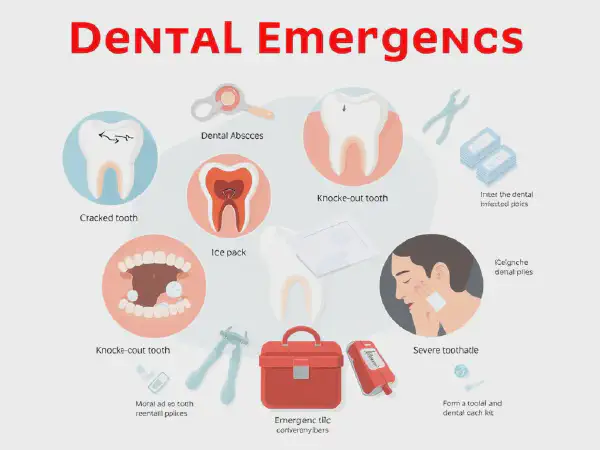Understanding Types of Dental Emergencies and What to Do

Understanding Types of Dental Emergencies and What to Do
Dental emergencies can arise unexpectedly and often require immediate attention. Understanding the types of dental emergencies and what to do can help alleviate pain, minimize complications, and save teeth. Knowing how to respond to dental situations will help in seeking timely care from a dental professional.
Common dental emergencies include toothaches, broken or cracked teeth, knocked-out teeth, abscessed teeth, and injuries to the gums and soft tissues. Each type of emergency has its own set of symptoms and urgent care protocols. Being prepared for these situations is crucial, as prompt treatment can make a significant difference in recovery and outcomes.
This article explores the different types of dental emergencies, providing insights into their causes, how to manage them, and when to seek professional help. By being informed, individuals can ensure their oral health is protected and avoid further complications.
Dental health is not just about routine check-ups, and understanding emergencies can prevent unnecessary discomfort and damage. Whether it's experiencing a sudden toothache or dealing with a knocked-out tooth, knowing the appropriate actions to take is vital. This guide covers essential information, equipping you to handle various dental emergencies effectively.
Ultimately, prevention is as important as treatment. Understanding the types of dental emergencies and what steps to take can reduce the risks associated with dental trauma and infections. This guide aims to educate, empower, and encourage proactive dental health management.
Toothache Management
Toothaches often signal underlying issues like cavities, gum disease, or tooth infections. Common causes include tooth decay, gum inflammation, abscess, or trauma. Sometimes, referred pain from sinus problems or jaw issues can also cause discomfort in the teeth.
For immediate pain relief, over-the-counter pain medications like ibuprofen or acetaminophen can be effective. Rinsing the mouth with warm saltwater may also provide temporary relief. Applying a cold compress on the outside of the cheek can reduce swelling and numb the pain as well.
It's important to see a dentist as soon as possible if the toothache persists, if you experience fever, swelling, or if the pain radiates to other areas. These could indicate a more serious condition that requires professional intervention.
Preventive measures include maintaining good oral hygiene by brushing twice a day, flossing, and visiting the dentist regularly for check-ups and cleanings to catch potential problems early.
Broken or Cracked Teeth
Broken or cracked teeth can result from trauma, biting hard foods, or dental neglect. Types of cracks include craze lines, fractures, and complete breaks. Identifying the severity and type of crack is essential for the right treatment plan.
For immediate aid after a tooth is broken, rinse your mouth gently with warm water to keep clean and apply a cold compress to the outside of your mouth to reduce swelling. Avoid chewing with the affected side and seek dental care promptly.
Long-term solutions may involve dental bonding, crowns, or root canal therapy, depending on the severity of the crack. Your dentist will evaluate and recommend the best approach to restore functionality and aesthetics.
Preventive care includes avoiding hard candies and ice, wearing a mouthguard during contact sports, and addressing any current dental issues before they worsen.
Knocked-Out Tooth
If a tooth gets knocked out, it’s essential to act quickly. Follow these steps: handle the tooth by the crown (not the root), rinse it gently with water if dirty, and place it back into the socket if possible. If not, store it in a container of milk or saline solution to keep it moist until you can reach the dentist.
To preserve a knocked-out tooth, ensure it remains moist. Do not scrub or remove any attached tissue fragments, as this can damage the cells that may allow for reattachment.
Dental reimplantation is often possible within an hour of the tooth being knocked out. The sooner you seek treatment, the greater the chances of successful re-implantation by a qualified dentist.
Post-reimplantation care involves maintaining good oral hygiene and following your dentist's guidance regarding diet and activities to promote healing.
Abscessed Tooth
An abscessed tooth presents as a pocket of pus caused by a bacterial infection, often resulting from untreated decay or trauma. Signs include severe toothache, swelling, foul taste in the mouth, and swelling in the gums or face.
Immediate treatment options include seeking a dentist for antibiotics to control the infection and possible drainage of the abscess to relieve pressure and pain.
Long-term implications of untreated dental abscesses can include serious complications such as spread of infection, tooth loss, and other systemic health issues, making prompt attention essential.
Preventive strategies include maintaining proper oral hygiene, addressing cavities and gum disease promptly, and avoiding excessive sugar intake to minimize plaque formation and decrease infection risk.
Gums and Soft Tissue Injuries
Common soft tissue injuries in the mouth can include cuts, punctures, or lacerations to the gums, cheeks, or tongue, often resulting from accidents, sports injuries, or dental procedures.
For first aid, rinse the mouth with cool water to clean the area gently. Applying a damp gauze to control bleeding for about 10 minutes can be helpful; if bleeding persists, seek immediate dental attention.
Signs of infection in gum injuries can include increased swelling, redness, pus discharge, and persistent pain. If any of these symptoms occur, contact a dentist promptly.
Caring for oral soft tissue injuries involves maintaining cleanliness, avoiding irritants like spicy foods, and applying ice to reduce swelling. Follow your dentist's care instructions for optimal recovery.
